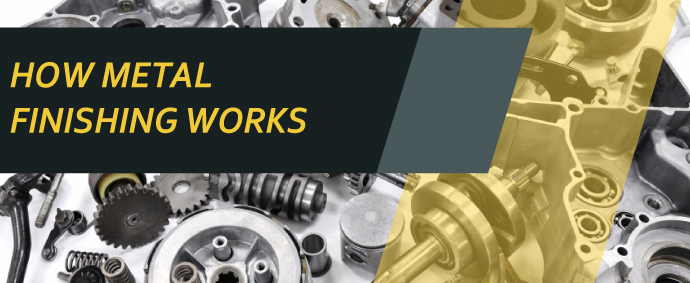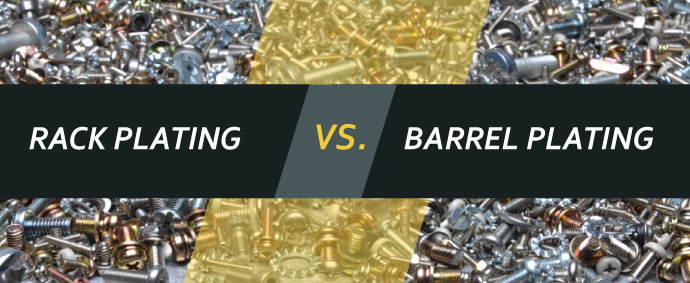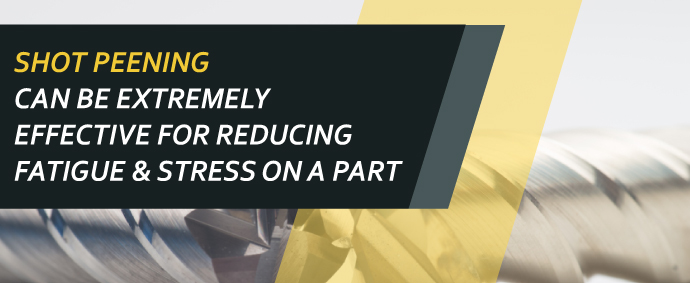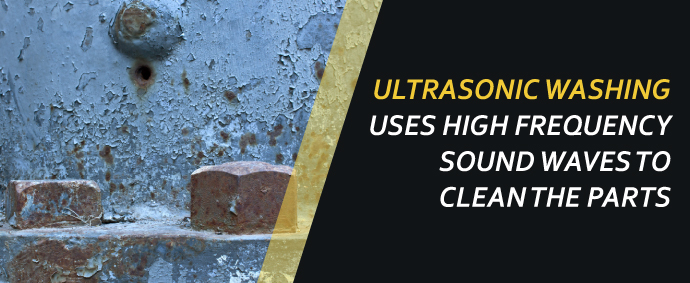Take a quick look around you and you’ll likely find one or several objects that include some type of metal — starting with the computer on which you’re reading this post! Metal has played a key role in our lives for thousands of years, and it has been an important component in just about every technological innovation. Think about how different our lives would be without automobiles, jewelry, dental fillings, nuts and bolts, and all of the other metal products we use today.
There are dozens of metals that we use in some form on a regular basis. Examples include copper, tin, zinc, lead and nickel, as well as relatively rare “precious” metals such as gold, silver, platinum and palladium. All of these are naturally occurring elements that are extracted from the earth’s crust. Each has its own distinct properties that are beneficial to man. However, each type of metal has inherent weaknesses that must be improved upon in order to maximize their utility. That’s where industrial metal finishing comes into play.
What Is Industrial Metal Finishing?
Metal finishing is an all-encompassing term used to describe the process of placing some type of metal coating on the surface of a metallic part, typically referred to as a substrate. It can also involve the implementation of a process for cleaning, polishing or otherwise improving a surface. Metal finishing often consists of electroplating, which is the process of depositing metal ions onto a substrate via an electric current. In fact, metal finishing and plating are sometimes used interchangeably. However, the metal finishing industry includes a wide range of processes, each offering its own user benefits.
Industrial metal finishing can serve many valuable purposes including:
- Limiting the impact of corrosion
- Serving as a primer coat to promote paint adhesion
- Strengthening the substrate and increasing wear resistance
- Reducing the effects of friction
- Improving the appearance of a part
- Increasing solderability
- Making a surface electrically conductive
- Enhancing chemical resistance
- Cleaning, polishing and removing surface defects
Let’s take a closer look at how metal finishing works by examining some of the most commonly used industrial metal finishing processes.
What is Electroplating?
Electroplating, also known as electrodeposition, involves the deposit of a metal or metal alloy onto the surface of a substrate. An electric current is passed through a liquid (referred to as a “bath”) that contains dissolved ions of the metal and the substrate. The object serves as a cathode and attracts the metal ions found in the plating bath. A pretreatment process that typically includes cleaning, rinsing and stripping is often employed prior to plating. Common bulk electroplating methods include rack plating, where the parts are affixed to a jig, and barrel plating, where numerous smaller parts are tumbled inside a barrel-shaped cage.
In addition to metallic surfaces, electroplating can also be used to coat plastics and other non-metallic materials. However, this process is extremely difficult to master and requires specialized plating expertise.
Electroless Plating
Electroless plating is similar to electroplating in that the substrate is placed in a liquid solution containing the desired metal, most often nickel or copper. The key difference is the way in which the deposition occurs. Instead of electricity, the metal coating is applied via chemical reaction. In addition to the source metal, the plating bath normally includes a complexing agent to maintain the metal solution and various chemicals that maintain stability and lengthen bath life.
Passivation
Passivation is sometimes employed as a post-treatment plating process, normally as a means of providing additional corrosion protection. Passivation involves the application of a metal oxide coating that can lengthen the time in which the onset of rust occurs. Passivates are available in a variety of colors, which can also enhance the appearance of the finished part.
Cladding
Cladding is a mechanical process where heat and pressure are used to create a bond between the substrate and the metal coating. Cladding can provide a thicker metal coating than either electroplating or electroless plating. It also requires a less stringent preparation process. However, cladding also involves the use of specialized equipment that generally makes it more costly than plating.
Case Hardening
One way to protect the surface of a metal surface is to make it harder. An industrial metal finishing process known as case hardening can accomplish this goal. Case hardening is a metallurgical process that adds protection through surface modification. This can be achieved through the implementation of one of many techniques such as micro-casing, carburizing and nitriding. Each of these processes can produce the desired hard case, while the underlying metal remains relatively soft. The protective case will ultimately increase the durability and wear resistance of the underlying work piece.
Hot Blackening
Hot blackening is most often used to provide a black matte finish on automotive parts and firearms, as well as for military applications where a protective dark coating is required. Hot blackening can also increase the abrasion resistance of a metal part. With hot blackening, a thin black oxide coating is applied to the surface of the substrate. The specific process involves allowing the parts to travel through a series of tanks containing various cleaning agents, caustic materials and coolants. Hot blackening is typically performed in large batches, making it ideally suited for smaller parts.
Powder Coating
Instead of using a liquid to coat a metal object, powder coating involves the application of a dry powder. In general, a powder coating can provide greater thickness than a liquid coating. The powder coating process works by combining an array of ingredients that includes pigments, curatives, flow modifiers, leveling agents and other additives to create the powder. The powder is then electrostatically deposited onto the surface of the substrate. The final step is to cure the parts in a specially designed oven, which produces a chemical reaction that results in high-link density. A powder coating can also be applied to some plastics and other non-metallic substrates.
What is Electropolishing?
Electropoloshing is an electrochemical metal finishing process that is considered to be the opposite of electroplating. Electroplating involves the deposition of metal ions onto the surface of the substrate. With electropolishing, the metal ions are removed from the substrate, resulting in a smooth, streamlined surface texture. This is accomplished by immersing the object into an electrolyte bath, which enables it to serve as the anode.
The object is also connected to a terminal that provides a DC power supply and serves as the cathode. Electropolishing is often applied to remove burrs or small amounts of debris from the surface, eliminating peaks and valleys, and polishing hard-to-reach areas. It can even be used to reduce the size of a part in some instances.
Buff Polishing
As with electropolishing, buff polishing can be used to clean and smooth the surface of a substrate. However, buff polishing does not involve creating any type of electrochemical reaction. Instead, a machine equipped with a cloth wheel is used to buff the surface, producing an action that is similar to buffing an automobile after waxing an automobile. Buff polishing is most often applied to provide a glossy, decorative finishing to metallic objects.
Mass Finishing
Mass finishing, also known as mechanical surface finishing, offers a cost-effective way to polish parts in bulk. Mass finishing actually encompasses a wide range of processes that can provide uniform cleaning, edge-breaking, smoothing and polishing smaller parts at once. This can significantly decrease production times. Common mass finishing techniques also include tumble finishing and vibratory finishing. Mass finishing processes typically involve the application of media that can consist of materials such as aluminum, steel, plastic or aluminum. The medium that is chosen will depend on the desired process result.
Shot Peening
Shot peening can be extremely effective for reducing metal fatigue and stress, preventing failure caused by corrosion and increasing the durability and lifespan of the part. To understand how shot peening works, it can be helpful to consider the principle applied when using a ball-peen hammer. Striking a metal object with the hammer will dimple the surface. The resulting compression stress will actually strengthen the surface of the object.
With shot peening, specially designed equipment is used to blast small projectiles known as shot. The projectiles can be made of ceramic, metal, glass or other material. The compression causes plasticity, or a permanent deformation of the surface, to occur.
Abrasive Blasting
Abrasive blasting, also known as sand blasting or bead blasting, offers a means of combining cleaning and finishing into one process, which can save time and money. With abrasive blasting, high-pressure compressed air is used to project a medium onto the surface of the part to perform the desired cleaning, polishing or finishing action.
A wide variety of media can be used, such as sand, silicon carbide, glass beads, aluminum steel grit or shot, or organic materials such as walnut shells or corn cobs. Generally, harder media is used when more aggressive cleaning action is required, while the softer materials are used on surfaces that are more susceptible to damage. The amount of pressure can also be adjusted to accommodate the specific cleaning or finishing requirements.
Soda Blasting
Soda blasting works in a similar fashion to abrasive blasting. The key difference is that baking soda is propelled onto the surface of the object instead of abrasive media. Soda blasting serves as a powerful method for removing grease, oil, rust, paint and other surface contaminants. However, it also provides a gentler cleaning action than abrasive blasting. The soda blasting process is usually employed on surfaces that are vulnerable to scratching.
Tumble Slurry Blasting
Tumble slurry blasting is often called wet blasting because of its use of hot water to provide the desired cleaning or surface preparation outcome. Wet blasting includes a three-part process that involves the application of an alkali hot water wash to prep the surface, the blasting of an abrasive slurry onto the surface, and another alkali hot water application to rinse the part. Tumble slurry blasting differs from other blasting processes, as a high-speed blast wheel is used to propel the slurry instead of compressed air. Common wet blasting applications include degreasing and the removal of oils and oxides.
Vibratory Finishing
Vibratory finishing can be an extremely effective process for removing rough edges and other surface imperfections. Parts are placed inside of a bowl or tub that also contains pellet-shaped media. Activation of the bowl results in a vibrating action that causes the media and parts to rub against each other, which creates the desired outcome. Typical vibratory finishing applications include edge-breaking, cleaning, descaling, burnishing or polishing of smaller parts.
Parts Cleaning
Proper cleaning of parts is often necessary for removing contaminants prior to the implementation of other industrial metal finishing processes. One commonly applied parts cleaning method is ultrasonic washing, where high frequency sound waves are used to produce an intensive scrubbing action for the removal of stubborn contaminants and debris.
Another effective parts cleaning method is continuous flow washing, a three-step process where the parts are placed on a conveyor belt and travel between washing, rinsing and drying stations. Both processes are ideally suited for fast and efficient cleaning of a high volume of smaller parts.
Choosing the Right Industrial Metal Finishing Process
A variety of factors should be considered when choosing an industrial metal finishing process. You’ll need to take into account the production speed. For instance, if your operation requires a quick turnaround time, you’ll need to choose a process that is compatible with your tight production deadlines. Another factor is the hardness of the metal or other substrate material you’re working with. A process that is overly abrasive could damage the part, while one that is too gentle may not achieve the desired result.
Of course, cost is always an important consideration. Taking some time to explore all available pricing alternatives can help save your company a substantial amount of money. For instance, a process such as electroplating with a precious metal may not fit your budget constraints. However, you may be able to achieve similar results at a lower overall cost by substituting a less expensive metal, like using palladium instead of gold.
Sharretts Plating Company: Your Source for Metal Finishing in Pennsylvania
SPC has been providing reliable metal finishing solutions since 1925. We’re one of the few metal finishing companies near Harrisburg, PA that can provide customized services for many of the processes mentioned in this post. Please contact us to learn more about our industrial metal finishing and plating services. Be sure to sign up to receive our informative e-newsletter – it’s a great way to stay up-to-date on the latest innovations in the ever-changing metal finishing industry.
updated 1/22/2019







